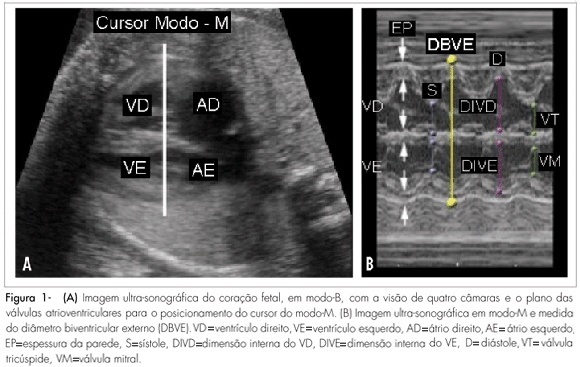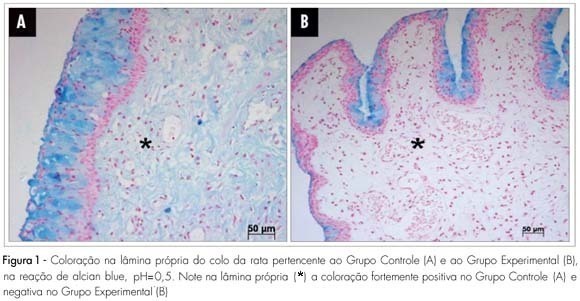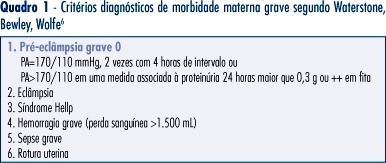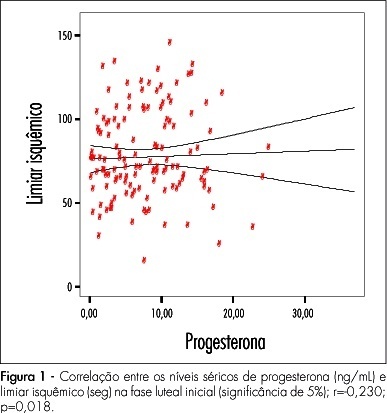Summary
Revista Brasileira de Ginecologia e Obstetrícia. 2008;30(7):341-348
DOI 10.1590/S0100-72032008000700004
PURPOSE: to verify the correlation between ultrasonography heart measures and hemoglobin deficit in fetuses of alloimmunized pregnant women. METHODS: a transversal study, including 60 fetuses, with 21 to 35 weeks of gestational age, from 56 isoimmunized pregnant women. A number of 139 procedures were performed. Before cordocentesis for the collection of fetal blood, cardiac measures and femur length (FL) were assessed by ultrasonography. The external biventricular diameter (EBVD) was obtained by measuring the distance between the epicardic external parts at the end of the diastole, with the M-mode cursor perpendicular to the interventricular septum, in the atrioventricular valves. The measure of the atrioventricular diameter (AVD) was obtained by positioning the same cursor along the interventricular septum, evaluating the distance between the heart basis and apex. The FL was determined from the trochanter major to the distal metaphysis. The cardiac circumference (CC) was also calculated. To adjust the cardiac measure to the gestational age, each of these measures were divided by the FL measure. Hemoglobin concentration has been determined by spectrophotometry with the Hemocue® system. Hemoglobin deficit calculation was based in the Nicolaides's normality curve. RESULTS: direct and significant correlations were observed between the cardiac measures evaluated and the hemoglobin deficit. To predict moderate and severe anemia, the sensitivity and specificity found were 71.7 and 66.3% for EBVD and FL, 65.8 and 62.4% for AVD and FL, and 73.7 and 60.4% for CC and FL, respectively. CONCLUSIONS: ultrasonography cardiac measures assessed from fetuses of isoimmunized pregnant women correlate directly with hemoglobin deficit.

Summary
Revista Brasileira de Ginecologia e Obstetrícia. 2008;30(7):335-340
DOI 10.1590/S0100-72032008000700003
PURPOSE: to evaluate the effect of exposure of female rats to therapeutic ultrasound in the pre-implantation phase. METHODS: pregnant Wistar female rats have been exposed to 3 MHz, 0.6 W/cm² ultrasound, pulsatile ultrasound (PUS) or continuous ultrasound (CUS), and controls, unplugged ultrasound (UUS), for five minutes. The rats were sacrificed at the 20th day post-insemination. Biochemical and hematological analyses have been done. Animals have been submitted to necropsy in order to identify lesions of internal organs, and to remove and weight the liver, kidneys and ovaries. Alive, malformed, dead and reabsorbed fetuses have been counted. RESULTS: the rats have not presented changes in their body and organs weight, and neither in their reproductive capacity, but there has been an increase in triglycerides in the PUS and CUS groups, when compared to the UUS group. The fetuses' relative weights of the heart (0.7 ± 0.9), liver (9.8 ± 0.8), kidneys (6.2 ± 0.8) and lungs (3.8 ± 0.4) increased in the CUS, when compared to the heart (0.7 ± 0.9), liver (9.8 ± 0.8), kidneys (6.2 ± 0.8) e lungs (3.8 ± 0.4) of the UUS. CONCLUSIONS: in the experimental model, the therapeutic ultrasound used has not caused meaningful maternal toxicity. Pulsatile waves have not changed fetal morphology, but continuous waves have caused increase in the relative weight of the fetuses' heart, liver, lungs and kidneys.
Summary
Revista Brasileira de Ginecologia e Obstetrícia. 2008;30(7):328-334
DOI 10.1590/S0100-72032008000700002
PURPOSE: to study the histochemical changes related to the uterine cervix glycosaminoglycan of the albino female rat, after local ministration of hyaluronidases at the end of pregnancy. METHODS: ten female rats with positive pregnancy tests were randomly distributed in two numerically equal groups. The control group (Cg) was built up with rats that received a single dose of 1 mL of distilled water in the uterine cervix, under anesthesia, at the 18th pregnancy day. In the experimental group (Exg), the rats received 0.02 mL of hyaluronidase, diluted in 0.98 mL of distilled water (1 mL as a total), under the same conditions as the Cg. At the 20th pregnancy day, the rats were anesthetized once again and submitted to dissection, and the cervix prepared for histochemical study with alcian blue dye and its blockades (pH=0.5, pH=2.5, methylation and saponification). RESULTS: strongly positive reaction in the lamina propria (+3) has been seen in the Cg, and negative reaction in the Exg, with pH=0.5 alcian blue staining. With pH=2.5, staining has also been strongly positive (+4) in the Cg, and weakly positive (+1) in the Exg slide. After methylation, both groups have shown negative reaction, with pH=2.5 alcian blue staining. The lamina propria staining became negative after methylation in both groups, followed by saponification and enzymatic digestion on slide. CONCLUSIONS: there is clear predominance of sulphated glycosaminoglycans in the Cg as compared to the Exg and a small amount of identified carboxylated glycosaminoglycans in the Exg. The changes evidenced in the extracellular matrix have suggested that the hyaluronidase injected in the uterine cervix has promoted biochemical changes compatible with cervix maturation.

Summary
Revista Brasileira de Ginecologia e Obstetrícia. 2008;30(6):274-280
DOI 10.1590/S0100-72032008000600002
PURPOSE: to assess the prevalence of group B streptococcus colonization (GBS) in pregnant women in prodrome or in labor. METHODS: vaginal and rectal cultures were collected from 201 pregnant women, in the admission sector of a public maternity center in the northeast region of Brazil (São Luís, Maranhão). The samples obtained were inoculated in a Todd-Hewith's selective culture medium and after that they were sub-cultivated in blood-agar plates. The CAMP (Christie, Atkins, Munch-Petersen) test was used to identify GBS, which was then serologically confirmed by the BioMérieux Api 20 Strep kit microtest. GBS positive samples were submitted to an antibiotic sensitivity test. Sociodemographic variables, gynecological-obstetrical antecedents, and perinatal outcomes were studied. The Epi-Info 3.3.2 programs from World Health Organization and Statistical Package for Social Sciences 14.0 version were used for the statistical analysis. The prevalence ratio was used as risk measure, considering p<0.05 as significance level, and accepting 80% power. RESULTS: the prevalence of SGB colonization in the mothers was 20.4%. There was no association between the sociodemographic variables or gynecological-obstetrical antecedents and a larger presence of SGB colonization. There were two cases of infectious outbreak among neonatal babies from colonized mothers, but hemocultures resulted negative. High resistance rates were found for the following antibiotics: clindamycin, 25.4%; erythromycin, 23.4% and ceftriaxone, 12.7%. CONCLUSIONS: the prevalence of SGB colonization was high among the mothers, similar to what had been described in other studies. The elevated rates of antimicrobial resistance, especially to ceftriaxone indicate the need for further studies to determine the serology of this agent and of orientation protocols for rational use of antimicrobials.
Summary
Revista Brasileira de Ginecologia e Obstetrícia. 2008;30(6):300-305
DOI 10.1590/S0100-72032008000600006
PURPOSE: to correlate the presence of yeast from the Candida genus in the oral and vaginal cavity of women with and without vulvovaginal candidiasis (VVC), with secretor IgA levels (IgAs) present in the saliva. METHODS: among the 51 women included, 13 presented VVC and 38 were the Control Group. An amount of 2.0 mL of saliva without stimulation was collected from each patient, plus vaginal secretion using a swab, which was then immersed in 2.0 mL of physiological solution. Samples were inseminated in Sabouraud dextrose agar with chloramphenicol for isolation and counting of colonies, and the isolated ones, phenotypically identified. IgA has been quantified in the saliva of the women from both groups, by the ELISA technique. RESULTS: in the 13 patients with clinical and mycological diagnosis of VVC, the mean of Candida colony producing unities by milliliter of vaginal secretion (cpu/mL) was 52,723, and 23.8% of the patients presented colonization in the oral mucosa with lower amount of cup/mL (6,030). The levels of IgAs in saliva were lower in the group with VVC (DO mean: 0.3), as compared to the IgA levels of the Control Group (DO mean: 0.6). Eleven patients (37%) from the Control Group presented Candida colonization in the oral cavity, with a lower cup/mL mean, when compared to the VVC Group. The Control Group also presented a lower amount of cpu/mL (1,973) in the vaginal cavity, when compared to the VVC Group (52,942). CONCLUSIONS: these results have demonstrated that patients with clinical diagnosis of vaginal candidiasis presented a higher amount of Candida both in the vaginal and in the oral cavity, and presented lower levels of anti-Candida IgA in the saliva.
Summary
Revista Brasileira de Ginecologia e Obstetrícia. 2008;30(6):281-286
DOI 10.1590/S0100-72032008000600003
PURPOSE: to assess the prevalence and risk factors associated with near miss and other severe maternal morbidity at a reference tertiary maternity. METHODS: this is a cross-sectional study on severe maternal morbidity at the Hospital e Maternidade Celso Pierro, Campinas, São Paulo, between October 2005 and July 2006, identified from infirmary, admission and delivery unit logbooks. Pregnant and post-partum women with severe maternal morbidity were identified according to clinical criteria proposed by Waterstone. Later, cases with more severe morbidity, called extremely severe maternal morbidity, were reclassified using Mantel criteria, based on organic dysfunction and clinical management. RESULTS: there were 114 severe maternal morbidity cases among 2,207 birth deliveries, with a ratio of other severe morbidity and extremely severe morbidity near miss of 44.9 and 6.8 cases/1,000 live births, respectively. Mean gestational age at delivery was 35 weeks, and 87% came from the reference area for the maternity service. Hypertension (severe pre-eclampsia) represented 96% of other severe morbidity, while hemorrhage represented 60% of all extremely severe cases, followed by hypertension. The prevalence of extremely severe morbidity among the severe morbidity cases was not associated with marital status, schooling, maternal age, type of delivery, parity, gestational age at birth and home place. CONCLUSIONS: the other morbidities were 6.6 times more frequent than near miss, and it was not possible to differentiate both groups by epidemiological risk factors.

Summary
Revista Brasileira de Ginecologia e Obstetrícia. 2008;30(6):306-311
DOI 10.1590/S0100-72032008000600007
PURPOSE: to investigate the relationship between pain perception (experimental pain threshold and tolerance, in response to ischemia and pressure) in young and healthy young women and female sexual hormone seric levels (estradiol and progesterone). METHODS: 18 volunteers have participated of this study, during three consecutive menstrual cycles. A pressure algometer and a manual dynamometer have been used to measure painful responses to pressure and ischemia algesic stimuli. Blood has been collected for assessment of both hormonal and painful variables, during three menstrual cycles, whose characterization was based on daily oral temperature record, a diary of the menstrual cycles with the onset and end of each cycle, and on estradiol and progesterone plasmatic levels. The average for the algesic variables measured has been compared by analysis of variance (ANOVA) and the Tukey-Kramer's post-test, among the menstrual cycle phases (follicular, periovulatory, early luteal, late luteal and menstrual). The Pearson's test has been used for correlation analysis between algesic and hormonal variables. Statistical significance has been defined as p<0.05. RESULTS: no significant change in pain parameters among the menstrual cycle phases has been observed. Nevertheless, there have been significant negative correlations between progesterone and ischemic threshold (r=-0.23; p<0.01), and pressure tolerance (r=-0.23; p<0.01) at the early luteal phase. CONCLUSIONS: these results indicate that the increase in progesterone levels correlates with a decrease of ischemic threshold and pressure tolerance, suggesting that progesterone plays a role in the pain modulation during the early luteal phase.
